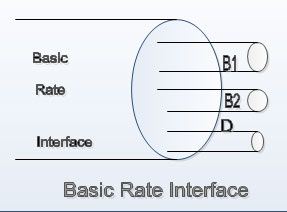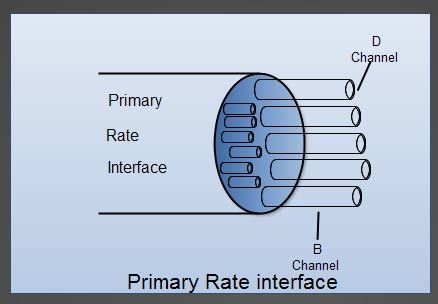Integrated Services Digital Network (ISDN) is a set of CCITT /ITU standards for digital transmission over ordinary telephone copper wire as well as over other media. This technology uses ISDN adapters in place of modems and provides very fast speed up. ISDN requires adapters at both ends of the transmission.
In the real world the delivery of multimedia requires a widespread network capable of delivering at high data rates. The current implementation of ISDN in the narrow band form is the best access and delivery medium available. ISDN is seen by many in the industry as the ramp through which multimedia networking will gain acceptance. The installed base of ISDN is growing rapidly throughout the world to provide connections among different countries. The governments of various countries are coming out with plans and policies to implement ISDN as soon as possible.
Integrated Services Digital Network in concept is the integration of both analog or voice data together with digital data over the same network. Although the ISDN integrates these on a medium designed for analog transmission, broadband ISDN (BISDN) will extend the integration of both services throughout the rest of the end-to-end path using fiber optic and radio media. Broadband· ISDN will encompass frame relay service for high-speed data that can be sent in large bursts, the Fiber Distributed- Data Interface (FDDI), and the Synchronous Optical Network (SONET). BISDN will support transmission from 2 Mbps up to much higher, but as yet unspecified rates.
We’ll be covering the following topics in this tutorial:
Definition of ISDN
ISDN is a network architecture in which digital technology is used to convey information from multiple networks to the end user. This information is end-to-end digital.
Features
- Offers point-to-point delivery
- Network access and network interconnection for multimedia.
- Different data rates from 64 Kbps up to 2 Mbps are commercially available which can meet many needs for transporting multimedia and is four to many times more than today’s analog modems
- Call set-up times are under one second. ISD N can dramatically speed up transfer of information over the Internet or over a remote LAN connection, especially rich media like graphics, audio or video or applications that normally run at LAN speeds.
- ISDN will be the feeder network for broadband ISDN based on ATM standards.
Although ISDN could be cheaper, particularly in the case of widespread use, it is likely to be cheaper than ATM connections and more widespread in availability for a long time. It is, therefore, an important tool in bringing multimedia applications to a wide range of users.
There are two forms of ISDN service:
Narrow Band ISDN
Narrow band ISDN is digital service where the transport speeds are 1.544 Mbps (TI) or less. Narrow band ISDN provides for the following services:
Circuit Switched Voice Circuit switched voice service is a digital voice service that offers many of the capabilities of a business. It is centered over a 4-wire ISDN Digital Subscriber Line (DSL).
Circuit Switched Data Circuit switched data service provides end-to-end digital service to pass data or video information over the public network. ISDN uses out-of-band signaling to establish and maintain data connections, which require special processing.
Low Speed Packet ISDN lines are equipped with a packet connection that is used to manage ISDN connections. This monitoring capability is provided by using the D channel on a DSL. The D channel is a 16 Kbps X.25 connection that is also capable of passing low speed packet while also relaying call processing information.
High Speed Packet ISDN lines are also equipped with two B channels. Each B channel is a 64Kbps channel that can be used for circuit switched voice, circuit switched data, or high-speed packet service. To provision high-speed packet service one or two of the 64 Kbps B channels are connected (permanent virtual circuit) to the packet network thus providing a 64 Kbps X.25 connection.
Broadband ISDN Service
Broadband ISDN Service is a digital service in excess of 1.544 Mbps. This digital service can be in the form of Frame Relay, SMDS, or ATM. Broadband ISDN is the service of the future. The higher speeds offered are required to support the many applications of the Information Super Highway. The range of speeds for the Broadband ISDN services usually range from 25 Mbps up to the Gigabit range. The two speeds that are most often discussed are OC I that is 155Mbps and OC 3 that is 622 Mbps. The speeds in the Broadband are made possible by the high quality of the digital facilities in place on the network. The early data protocols such as X.25 required extensive overhead to insure the delivery of data. Error correction and flow control were performed at a number of intermittent points along the way of a data connection. The new digital facilities and the introduction of fiber optics have -eliminated this need up to a maximum extent. High-speed broadband services rely for the most part on the upper layer protocols to perform these functions on an end-to-end basis.
ISDN is accessed through one of two services, named by the CCITT as Basic Rate Access (BRA)and Primary Rate Access (PRA). Both rates include a number of B (bearer) channels and a D (delta) channel. The B channels carry data, voice, and other services. The D channel carries control and signaling information.
Basic Rate Access (BRA) provides an ISDN user with simultaneous access to two 64 Kbps data channels using the existing twisted pair copper telephone cable. Each data channel is referred to as a B-channel and can carry voice or data. Another channel, the D-channel, operates at 16 Kbps and is used for signaling between user devices and the ISDN. The total data rate of BRA is therefore 144 Kbps. The two B-channels and the single signaling channel give rise to the term 2B+D. BRA is also referred to as 1.420,after the CCITT recommendation. Basic rate ISDN is intended for low capacity usage, such as that required for small businesses.

Primary rate access service provides up to 30 independent 64 Kbps B channels and a separate 64 Kbps D channel to carry the signaling. This basically provides digital access via a T I line. A TI line provides a 1.544 bandwidth. This bandwidth is divided into twenty-four 64Kb channels. The ISDN PRI service uses 23 of the T1 channels to provide B channel access and uses the 24th channel for signaling purposes. ISDN call control procedures use packet messages to initiate, monitor, and release connections. In a BRI connection these messages are routed via the D channel. On the PRI service the /connection/call control messages are routed over the 24th channel which is the D channel in this instance. The total data rate of PRA is 1.544 Mbps. Primary rate access is often referred to as 23B+D because of the number of B-channels and D-channels, or 1.421 because of the CCITT recommendation from which it is taken. This form of access is primarily intended for use in situations which require a large transmission capacity, such as when organizations make voice and, data calls through an Integrated Services PBX.
 Dinesh Thakur holds an B.C.A, MCDBA, MCSD certifications. Dinesh authors the hugely popular
Dinesh Thakur holds an B.C.A, MCDBA, MCSD certifications. Dinesh authors the hugely popular